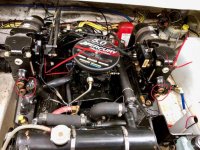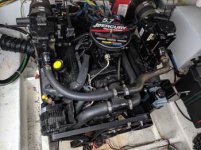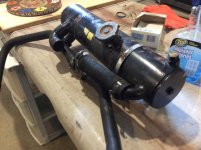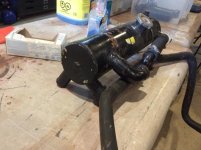I Want to put heat exchanger on my 5.7 mercruiser. got it figured out but don’t know what to do with the exhaust hoses to the risers?can I remove them and put a plug in the riser? see photo . Are the lower hoses enough for exhaust with a half cooling system? See photos.
From what I see, you have exhaust manifolds with spacers/risers directly above them, and exhaust elbows directly above the spacers/risers.
You also have what is called a "dry joint" system.
Your new heat exchanger is equipped with a single "spent" seawater outlet that sends the spent seawater to a T style diverter/splitter fitting.
This T style diverter/spitter sends an equal amount of "spent" seawater to each exhaust manifold.
Your spacers/risers will need to be equipped with open gaskets (both under and above).
The single "spent" seawater outlet and T diverter/splitter fitting prevents the system from sending seawater to the manifolds and elbows individually!
You will feed the spent seawater to each exhaust manifold, where it will then move up through the spacer/riser (open gaskets), enter the elbow where it will eventually go out with the exhaust gasses.
Compare the above with the instructions that you received with the H/E kit.
As for installing a Closed Cooling System on a previously raw water cooled engine, yes..... there will be a few obstacles/challenges.
The largest obstacle will be previous rust scale coming loose and building up around the exterior of the H/E's tube bundle.....( I.E., the E/G (ethylene glycol) side. )
Rust scale in this area will eventually diminish the tube bundle's ability to remove engine heat from the E/G, possibly resulting in over-heating.
Suggestion:
After XX hours of run time, drain the heat exchanger and remove it from the engine.
Flush the E/G side with warm soapy water and dump the contents into a clean white 5 gallon bucket.
Repeat this!
Look for rust scale debris.
Neutralize the soapy water, and re-install.
Fill the H/E with the proper amount of coolant.
Purge any air from the system.
Run it, and repeat this process in another XX hours until you no longer see a threatening amount of rust scale debris.
This has been done successfully in the past.
Now when winterizing, you will drain the seawater side of the H/E and the exhaust system, along with any other components that require winterizing.
.





